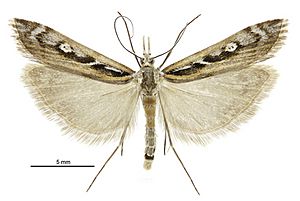Kupe's grassmoth facts for kids
Quick facts for kids Kupe's grassmoth |
|
|---|---|
 |
|
| Male | |
| Conservation status | |
 Nationally Vulnerable (NZ TCS) |
|
| Scientific classification | |
| Genus: |
Kupea (moth)
|
| Species: |
electilis
|
The Kupea is a special type of moth that belongs to the Crambidae family. It was first described by Alfred Philpott in 1930. This genus has only one known species, called Kupea electilis, which is also known as Kupe's grassmoth. This moth is found only in New Zealand.
The Department of Conservation has listed Kupe's grassmoth as "Nationally Vulnerable." This means it needs protection because its numbers are low. For a long time, only male moths were known. But in 2012, the female of the species was finally discovered!
Contents
Discovering Kupe's Grassmoth
Kupea electilis was first officially described in 1930 by Alfred Philpott. He used a male moth specimen that was found by Stuart Lindsay in March at Birdling's Flat, which is part of Kaitorete Spit.
Later, in 1939, George Vernon Hudson also wrote about and drew pictures of this moth. A scientist named David E. Gaskin suggested in 1975 that once a female moth was found, scientists should look again at where this moth fits in the family tree of insects. The original specimen, called the type specimen, is kept safe at the Canterbury Museum.
What Kupe's Grassmoth Looks Like
The adult male Kupe's grassmoth has front wings that are a shiny, brassy-yellow color. They have some gray areas and a dark brownish-black spot with a white line after it. Their back wings are brownish.
Interestingly, the male moths can only fly a little bit. The female moths are even more unique because they have very short wings and cannot fly at all! This is called brachypterous.
Where Kupe's Grassmoth Lives
Kupe's grassmoth is endemic to New Zealand. This means it is found naturally nowhere else in the world. So far, it has only ever been seen in areas around Kaitorete Spit in Canterbury. As mentioned before, the female moth was first found in 2012, which was a big discovery!
Life Cycle of the Moth
The young moths, called larvae, live inside a special cocoon. They build this cocoon using silk and sand. Inside their sandy home, they eat dried pieces of their host plant.
Adult moths are usually seen flying (or trying to fly) from mid-March to mid-April. We don't know exactly when they are most active during the day. This is because Kupea electilis moths are not attracted to lights, which is how scientists often find moths. However, some scientists think they might be active around twilight, which is the time just before sunrise or after sunset.
Home and Food
This special moth lives in sandy areas, often behind the first sand dunes and in low dunes further inland. The main plant that this moth relies on for food is an endemic plant called Zoysia minima. Endemic means this plant also only grows naturally in New Zealand.
Protecting Kupe's Grassmoth
Kupea electilis is listed as "Nationally Vulnerable" under the New Zealand Threat Classification System. This means it is at risk of becoming endangered if we don't protect it.
There are several things that threaten this unique moth:
- Grazing animals: Animals like cattle and introduced pests such as rabbits can eat the Zoysia minima plant, which is the moth's only food source.
- Weed invasion: Other plants, like sea spurge, can grow in the moth's habitat and take over, pushing out the native plants it needs.
- Human activity: Building or using the land where the moths live can also harm their habitat.
Protecting these sandy areas and the Zoysia minima plant is very important to help Kupe's grassmoth survive.

